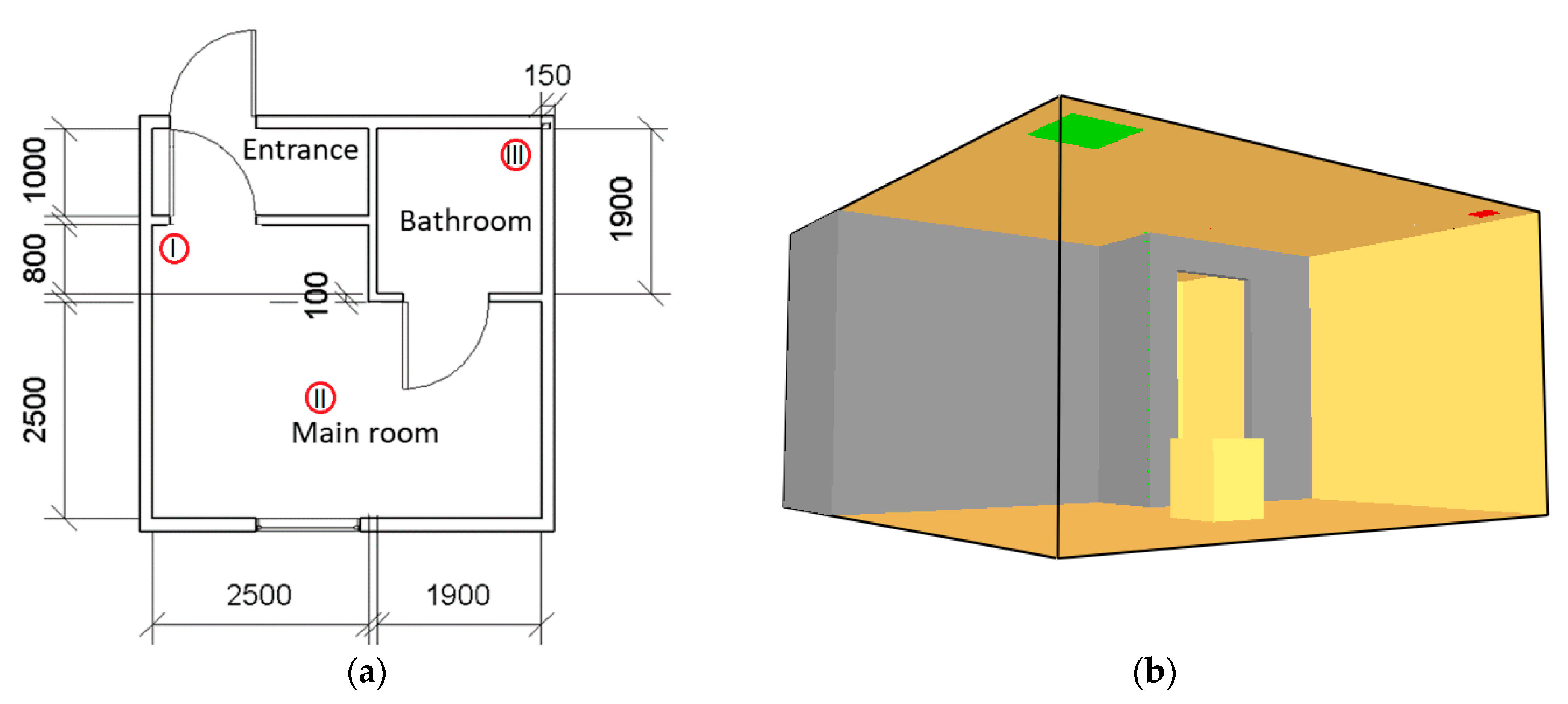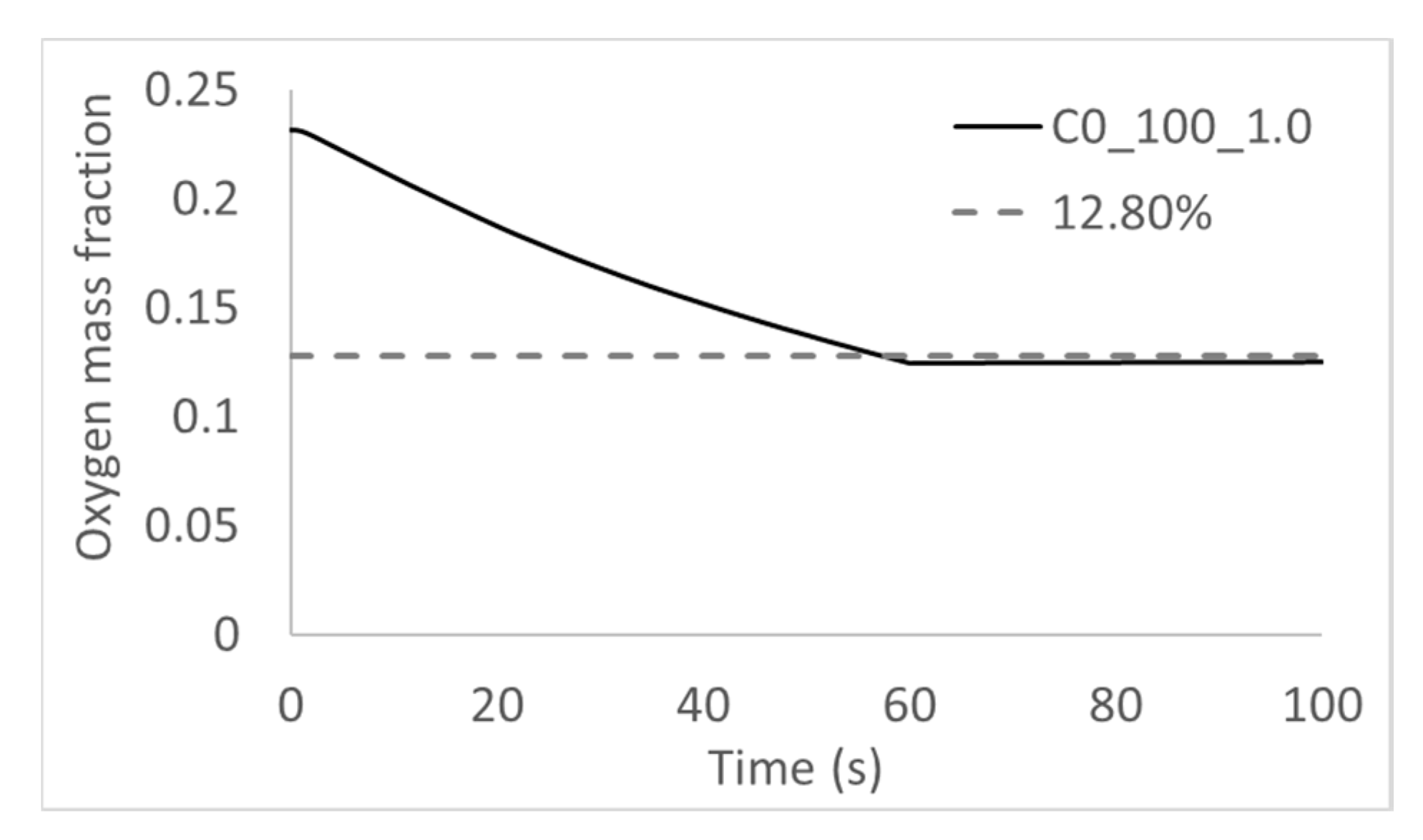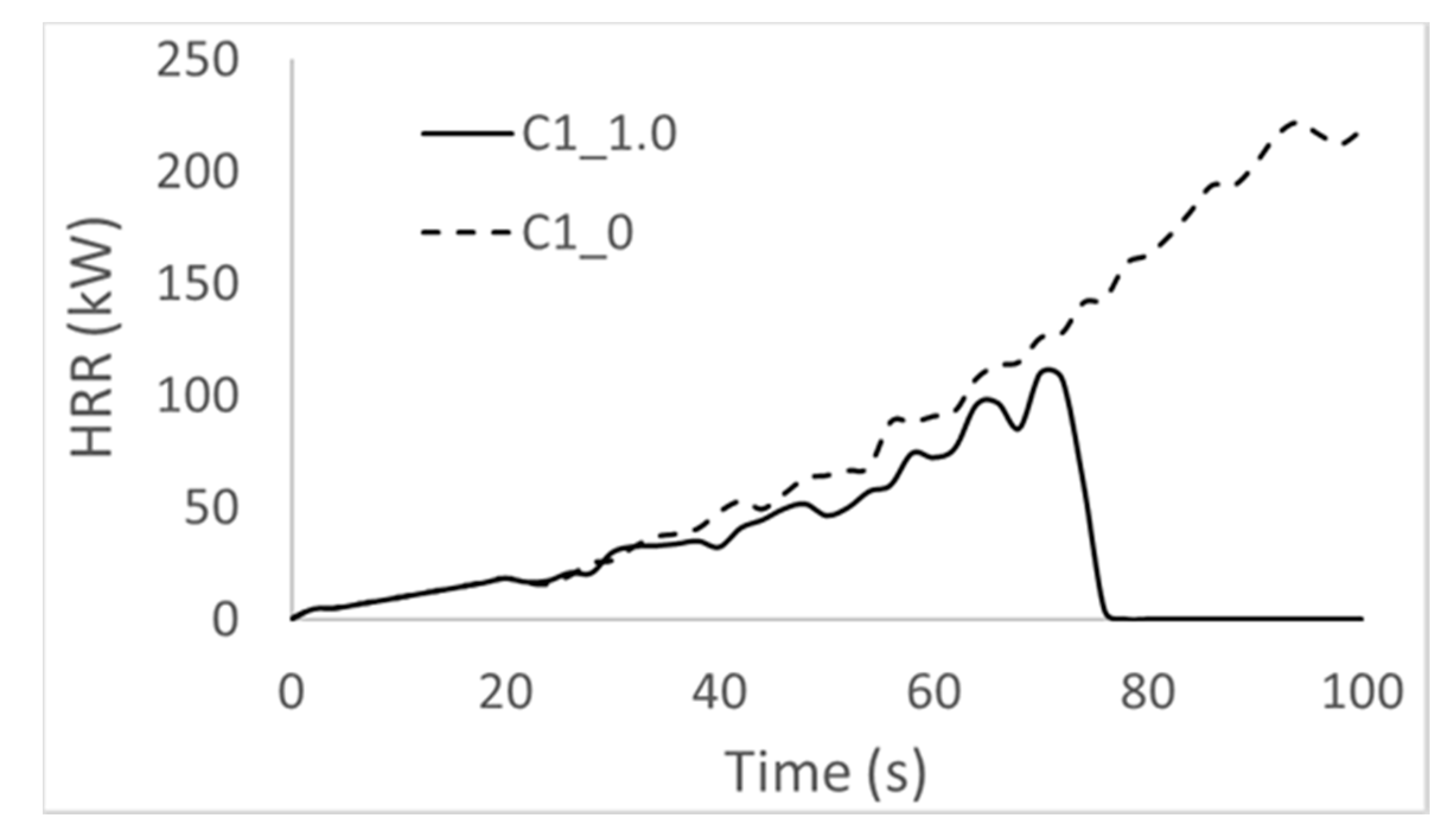Numerical Investigation of the Required Quantity of Inert Gas Agents in Fire Suppression Systems
Abstract
1. Introduction
2. Required Quantity of Inert Gas Agents
2.1. Limiting Oxygen Mass Fraction
2.2. Discharge Mass Rate of Inert Gas Agents
2.3. Discharge Volume Rate of Inert Gas Agents
2.4. Required Quantity of Inert Gas Agents
3. Numerical Investigation
- Is the design oxygen level obtained at the end of the discharge period?
- What is the variation of oxygen fraction along the enclosure height?
- Would the pressure in an enclosure exceed the resistance value of 500 Pa during the discharge period?
- What about the extinguishing efficiency of the inert gas agents?
4. Simulation Results and Discussion
5. Conclusions and Suggestions for Future Studies
- The design oxygen level could be approximately obtained at the end of the discharge period if the discharge rate and ventilation rate are calculated from the suggested equations. The obtained oxygen level in an enclosure can be slightly influenced by the density of inert gas agents.
- Oxygen fraction varies with height as a result of density differences between air and inert gas agents. The oxygen mass fraction was normally below the design level at the lower half of the enclosure.
- To avoid enclosure over-pressure effects, the discharge volume rate should be close to the ventilation volume rate.
- For the case with a chair fire, the HRR dropped to zero before the end of the discharge period partly due to the oxygen consumed in combustion.
Author Contributions
Funding
Conflicts of Interest
Nomenclature
| average specific heat (kJ/(kg∙K)) | |
| ventilation mass rate of mixture (kg/s) | |
| ventilation volume rate of mixture (m3/s) | |
| energy released per unit mass of oxygen consumed (kJ/kg) | |
| HRR | heat release rate (kW) |
| k | ratio of ventilation rate to discharge rate |
| total mass of gases in the enclosure (kg) | |
| total mass in the enclosure at start (kg) | |
| discharge quantity of agents (kg) | |
| energy (kJ) | |
| discharge mass rate of agents (kg/s) | |
| discharge volume rate of agents (m3/s) | |
| t | time (s) |
| TCFT | critical flame temperature (K) |
| ambient temperature (K) | |
| volume of an enclosure (m3) | |
| standard volume (m3) | |
| mass fraction | |
| air mass fraction in mixture | |
| oxygen mass fraction in mixture | |
| design oxygen mass fraction | |
| air volume fraction in mixture | |
| oxygen volume fraction in mixture | |
| design oxygen fraction | |
| volume fraction | |
| limiting oxygen fraction to sustain a flame | |
| ρ | density (kg/m3) |
References
- Grant, C.C. Halon design calculations. In SFPE Handbook of Fire Protection Engineering, 5th ed.; Hurley, M.J., Gottuk, D.T., Hall, J.R., Jr., Harada, K., Kuligowski, E.D., Puchovsky, M., Torero, J.L., Watts, J.M., Jr., Wieczorek, C.J., Eds.; Springer: New York, NY, USA, 2016; Chapter 43; pp. 1450–1482. [Google Scholar] [CrossRef]
- DiNenno, P.J.; Forssell, E.W. Clean agent total flooding fire extinguishing systems. In SFPE Handbook of Fire Protection Engineering, 5th ed.; Hurley, M.J., Gottuk, D.T., Hall, J.R., Jr., Harada, K., Kuligowski, E.D., Puchovsky, M., Torero, J.L., Watts, J.M., Jr., Wieczorek, C.J., Eds.; Springer: New York, NY, USA, 2016; Chapter 44; pp. 1483–1530. [Google Scholar] [CrossRef]
- Forssell, E.W.; Back, G.G.; Beyler, C.L.; DiNenno, P.J.; Hansen, R.; Beene, D. An evaluation of the international maritime organization’s gaseous agents test protocol. Fire Technol. 2001, 37, 37–67. [Google Scholar] [CrossRef]
- Zou, Y.; Vahdat, N.; Collins, M. Fire protection with bromoalkene/nitrogen gaseous mixtures. Ind. Eng. Chem. Res. 2001, 40, 4649–4653. [Google Scholar] [CrossRef]
- Senecal, J.A. Flame extinguishing in the cup-burner by inert gases. Fire Saf. J. 2005, 40, 579–591. [Google Scholar] [CrossRef]
- Yu, H.Z.; Kasiski, R.; Daelhousen, M. Characterization of Twin-Fluid (Water Mist and Inert Gas) Fire Extinguishing Systems by Testing and Modeling. Fire Technol. 2015, 51, 923–950. [Google Scholar] [CrossRef]
- Khattri, S.K.; Log, T.; Kraaijeveld, A. Tunnel Fire Dynamics as a Function of Longitudinal Ventilation Air Oxygen Content. Sustainability 2019, 11, 203. [Google Scholar] [CrossRef]
- De Rosa, M.I.; Litton, C.D. Effectiveness of various concentrations of an inert gas mixture for preventing and suppressing mining equipment cab fires: Development of a dual cab fire inerting system. Fire Technol. 2007, 43, 29–44. [Google Scholar] [CrossRef]
- Laursen, T. Fire protection for weak citizens. In Proceedings of the Nordic Fire and Safety Days, Copenhagen, Denmark, 20–21 August 2019. [Google Scholar] [CrossRef]
- Wang, Y.; Meng, X.; Ji, W.; Pei, B.; Lin, C.; Feng, H.; Zheng, L. The Inhibition Effect of Gas–Solid Two-Phase Inhibitors on Methane Explosion. Energies 2019, 12, 398. [Google Scholar] [CrossRef]
- Li, M.H.; Xu, J.C.; Wang, C.J.; Wang, B.Z. Thermal and kinetics mechanism of explosion mitigation of methane-air mixture by N-2/CO2 in a closed compartment. Fuel 2019, 255. [Google Scholar] [CrossRef]
- Bakka, M.S.; Handal, E.K.; Log, T. Analysis of a High-Voltage Room Quasi-Smoke Gas Explosion. Energies 2020, 13, 601. [Google Scholar] [CrossRef]
- Kraaijeveld, A. Rapport Vedrørende Anvendelse av IG-541 Som Alternative til Sprinkleranlegg; Western Norway University of Applied Sciences: Bergen, Norway, 2018. [Google Scholar]
- Bettati. Design Manual for Inert Gas System IG 100-IG01-IG55-IG541; Bettati Antincendio: Reggio Emilia, Italy, 2010. [Google Scholar]
- Wickham, R.T. Review of the Use of Carbon Dioxide Total Flooding Fire Extinguishing Systems. 2003. Available online: www.epa.gov/snap/review-use-carbon-dioxide-total-flooding-fire-extinguishing-systems (accessed on 6 January 2020).
- Akyuz, E. Quantification of human error probability towards the gas inerting process on-board crude oil tankers. Saf. Sci. 2015, 80, 77–86. [Google Scholar] [CrossRef]
- National Fire Protection Association. Standard on Clean Agent Fire Extinguishing Systems; National Fire Protection Association: Quincy, MA, USA, 2001. [Google Scholar]
- Lambertsen, C.J.; Gelfand, R. Comparison of CO2-Induced Improvements in Arterial SaO2 during Abrupt Exposures of Human Subjects to. 12 and. 10 ATA Inspired O2 in N2, in Rest and Exercise; Undersea and Hyperbaric Medical Society: North Palm Beach, FL, USA, 1996. [Google Scholar]
- Ansul. Clean Fire Extinguishing Agents Human Safety Testing; Tyco Fire & Security, Ansul Incorporated: Marinette, WI, USA, 2004. [Google Scholar]
- McGrattan, K.; Hostikka, S.; McDermott, R.; Floyd, J.; Weinschenk, C.; Overholt, K. Fire Dynamics Simulator usEr’s Guide, 6th ed.; NIST Special Publication: Gaithersburg, MD, USA, 2017. [CrossRef]
- Zimny, M.; Antosiewicz, P.; Krajewski, G.; Burdzy, T.; Krasuski, A.; Węgrzyński, W. Several Problems with Froude-Number Based Scale Modeling of Fires in Small Compartments. Energies 2019, 12, 3625. [Google Scholar] [CrossRef]
- Brzezińska, D. Ventilation System Influence on Hydrogen Explosion Hazards in Industrial Lead-Acid Battery Rooms. Energies 2018, 11, 2086. [Google Scholar] [CrossRef]
- McGrattan, K.; Hostikka, S.; McDermott, R.; Floyd, J.; Weinschenk, C.; Overholt, K. Fire Dynamics Simulator Technical Reference Guide Volume 1: Mathematical Model, 6th ed.; NIST Special Publication No. 1018; NIST: Gaithersburg, MD, USA, 2013.
- Beyler, C. Flammability limits of premixed and diffusion flames. In SFPE Handbook of Fire Protection Engineering, 5th ed.; Hurley, M.J., Gottuk, D.T., Hall, J.R., Jr., Harada, K., Kuligowski, E.D., Puchovsky, M., Torero, J.L., Watts, J.M., Jr., Wieczorek, C.J., Eds.; SFPE: Gaithersburg, MD, USA, 2016; Chapter 17; pp. 529–553. [Google Scholar] [CrossRef]
- Huggett, C. Estimation of rate of heat release by means of oxygen consumption measurements. Fire Mater. 1980, 4, 61–65. [Google Scholar] [CrossRef]
- Karlsson, B.; Quintiere, J.G. Enclosure Fire Dynamics; CRC Press LLC: London, UK, 1999; pp. 38–59. ISBN 0-8493-1300-7. [Google Scholar]
- Simmons, R.F.; Wolfhard, H.G. Some Limiting Oxygen Concentrations for Diffusion Flames in Air Diluted with Nitrogen. Combust. Flame 1957, 1, 155–161. [Google Scholar] [CrossRef]
- Kraaijeveld, A. Fire protection of at risk groups by IG-541 and water based sprinklers: Full scale tests. In Proceedings of the Nordic Fire and Safety Days, Copenhagen, Denmark, 20–21 August 2019. [Google Scholar] [CrossRef]
- O’Rourke, S.T. Analysis of Hold Times for Gaseous Fire Suppression Agents in Total Flooding Applications. Master’s Thesis, University of Maryland, College Park, MD, USA, 2005. [Google Scholar]
- Graf, S.H. Ignition Temperatures of Various Papers, Woods, and Fabrics; Oregon State College, Engineering Experiment Station: Corvallis, OR, USA, 1949. [Google Scholar]
- Boron, S.; Wegrzynski, W.; Kubica, P.; Czarnecki, L. Numerical Modelling of the Fire Extinguishing Gas Retention in Small Compartments. Appl. Sci. 2019, 9, 663. [Google Scholar] [CrossRef]
- Kubica, P.; Czarnecki, L.; Boron, S.; Wegrzynski, W. Maximizing the retention time of inert gases used in fixed gaseous extinguishing systems. Fire Saf. J. 2016, 80, 1–8. [Google Scholar] [CrossRef]







| Agent | Chemical Formula | Density (kg/m3) | Isobaric Mass Heat Capacity (kJ/kg K) |
|---|---|---|---|
| IG-100 | N2 | 1.16 | 1.04 |
| IG-541 | 52% N2, 40% Ar, 8% CO2 | 1.42 | 0.78 |
| HRR (kW) | Discharge Period | Inert Gas Agent | Case Index | |||
|---|---|---|---|---|---|---|
| HRR = 0 | 12.8% | 0–60 s | IG-100 | 0.8 | 0.4220 | C0_100_0.8 |
| HRR = 0 | 12.8% | 0–60 s | IG-100 | 0.9 | 0.4095 | C0_100_0.9 |
| HRR = 0 | 12.8% | 0–60 s | IG-100 | 1.0 | 0.3973 | C0_100_1.0 |
| HRR = 0 | 12.8% | 0–60 s | IG-100 | 1.1 | 0.3855 | C0_100_1.1 |
| HRR = 0 | 12.8% | 0–60 s | IG-100 | 1.2 | 0.3473 | C0_100_1.2 |
| HRR = 0 | 12.8% | 0–60 s | IG-541 | 0.8 | 0.3559 | C0_541_0.8 |
| HRR = 0 | 12.8% | 0–60 s | IG-541 | 0.9 | 0.3467 | C0_541_0.9 |
| HRR = 0 | 12.8% | 0–60 s | IG-541 | 1.0 | 0.3380 | C0_541_1.0 |
| HRR = 0 | 12.8% | 0–60 s | IG-541 | 1.1 | 0.3294 | C0_541_1.1 |
| HRR = 0 | 12.8% | 0–60 s | IG-541 | 1.2 | 0.3211 | C0_541_1.2 |
| HRR = ∙t2 | - | - | - | - | - | C1_0 |
| HRR = ∙t2 | 12.8% | 30–90 s | IG-541 | 1.0 | 0.3380 | C1_1.0 |
| Case Index | Pressure Difference (Pa) | |
|---|---|---|
| C0_100_0.8 | 11.9% | 1.79 × 104 |
| C0_100_0.9 | 12.1% | 8.30 × 103 |
| C0_100_1.0 | 12.5% | 23.3 |
| C0_100_1.1 | 12.8% | −7.14 × 103 |
| C0_100_1.2 | 13.0% | −1.33 × 104 |
| C0_541_0.8 | 11.1% | 1.50 × 104 |
| C0_541_0.9 | 11.3% | 7.11 × 104 |
| C0_541_1.0 | 11.4% | 25.1 |
| C0_541_1.1 | 11.6% | −6.7 × 103 |
| C0_541_1.2 | 11.8% | −1.17 × 104 |
© 2020 by the authors. Licensee MDPI, Basel, Switzerland. This article is an open access article distributed under the terms and conditions of the Creative Commons Attribution (CC BY) license (http://creativecommons.org/licenses/by/4.0/).
Share and Cite
Hu, X.; Kraaijeveld, A.; Log, T. Numerical Investigation of the Required Quantity of Inert Gas Agents in Fire Suppression Systems. Energies 2020, 13, 2536. https://doi.org/10.3390/en13102536
Hu X, Kraaijeveld A, Log T. Numerical Investigation of the Required Quantity of Inert Gas Agents in Fire Suppression Systems. Energies. 2020; 13(10):2536. https://doi.org/10.3390/en13102536
Chicago/Turabian StyleHu, Xiaoqin, Arjen Kraaijeveld, and Torgrim Log. 2020. "Numerical Investigation of the Required Quantity of Inert Gas Agents in Fire Suppression Systems" Energies 13, no. 10: 2536. https://doi.org/10.3390/en13102536
APA StyleHu, X., Kraaijeveld, A., & Log, T. (2020). Numerical Investigation of the Required Quantity of Inert Gas Agents in Fire Suppression Systems. Energies, 13(10), 2536. https://doi.org/10.3390/en13102536







